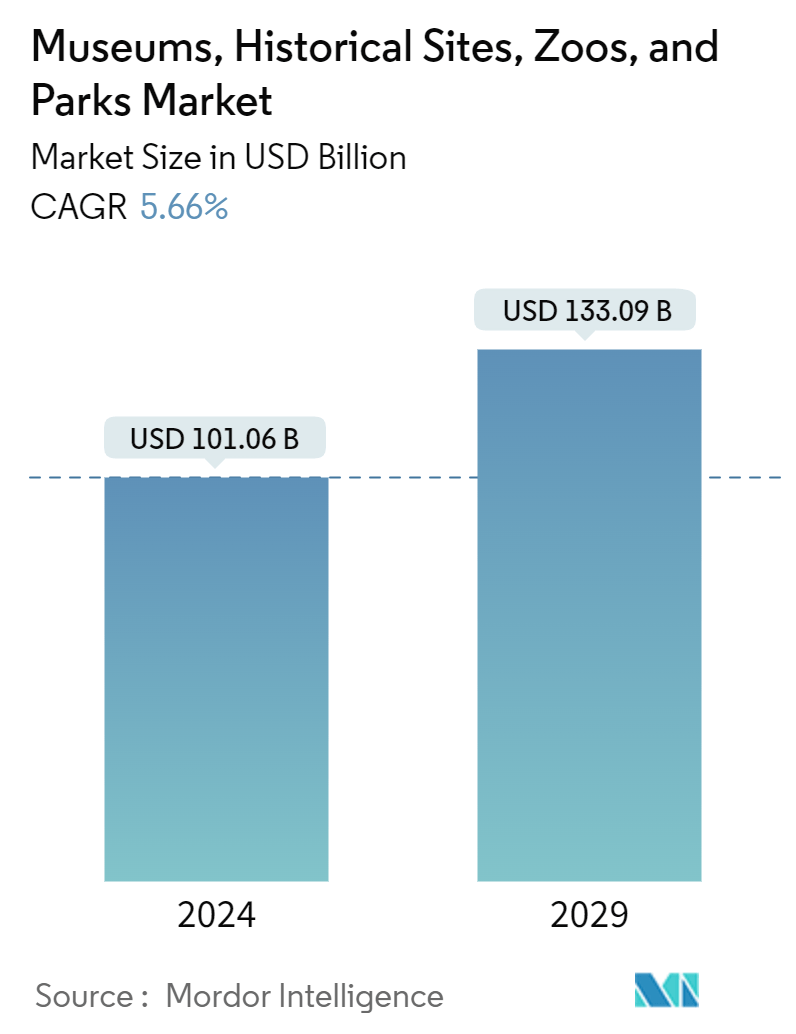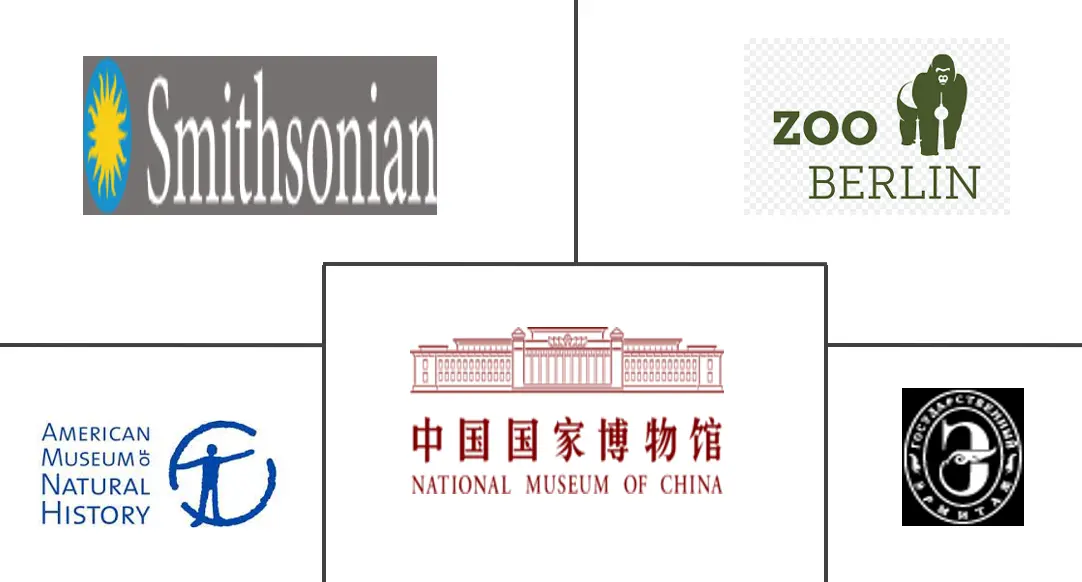Market Size of Museums, Historical Sites, Zoos, And Parks Industry

| Study Period | 2020 - 2029 |
| Market Size (2024) | USD 101.06 Billion |
| Market Size (2029) | USD 133.09 Billion |
| CAGR (2024 - 2029) | 5.66 % |
| Fastest Growing Market | Europe |
| Largest Market | North America |
Major Players
*Disclaimer: Major Players sorted in no particular order |
Museums, Historical Sites, Zoos, And Parks Market Analysis
The Museums, Historical Sites, Zoos, And Parks Market size is estimated at USD 101.06 billion in 2024, and is expected to reach USD 133.09 billion by 2029, growing at a CAGR of 5.66% during the forecast period (2024-2029).
A museum functions as a repository for priceless artifacts, including historical relics and artworks, offering public access for research and exhibition purposes. These establishments serve various objectives, such as providing leisure activities, supporting academic study, and enriching the cultural life of communities. Additionally, museums contribute to tourism promotion and the dissemination of ideological concepts.
Historical sites, also known as heritage sites, preserve relics of social, political, or military significance, often receiving legal protection and official national historic designations. These sites encompass structures, locations, or settings deemed historically important, typically aged at least 50 years.
Zoos provide habitats for wild animals, serving purposes such as research, conservation, and public education. National parks are governmental reserves dedicated to preserving natural environments, crucial for biodiversity conservation and outdoor recreation, offering visitors opportunities to appreciate and learn about nature's wonders.
Efforts are continuously made to enhance visitor experiences, including the development of digital resources and service platforms. Digital initiatives allow individuals to explore collections online, ensuring accessibility and engagement, particularly for students who may not have the opportunity to visit in person.
Museums, Historical Sites, Zoos, And Parks Industry Segmentation
A museum is a place where a great deal of one-of-a-kind and priceless goods, like historical artifacts or pieces of art, are maintained, examined, and presented to the general public. An official location where artifacts from social, political, or military history have been preserved for cultural heritage purposes is referred to as a historic site or heritage site. A zoo is a collection of wild animals kept in a park or garden for research, conservation, or public display, whereas a national park is a government-designated area set aside for environmental preservation. Museums, Historical Sites, Zoos, And Parks report will cover insights into the Museums, Historical Sites, Zoos, And Parks sector in the world, drivers, and restraints of the market. The report will also cover information on some of the major players active globally.
Museums, historical sites, zoos, and parks are segmented by type, by revenue source, by geography. By type, the market is sub-segmented into museums, historical sites, zoos and botanical gardens, nature parks, and other similar institutions. By revenue source, the market is sub-segmented into tickets, food and beverages, and other revenue sources, and by geography market is segmented into North America, Europe, Asia-Pacific, Latin America, and Middle-East and Africa. The market sizes and forecasts for museums, historical sites, zoos, and parks are provided in value (USD) for all the above segments.
| By Type | |
| Museums | |
| Historical Sites | |
| Zoos And Botanical Gardens | |
| Nature Parks | |
| Other Similar Institutions |
| By Revenue Source | |
| Tickets | |
| Food And Beverages | |
| Other Revenue Souces |
| By Geography | |
| North America | |
| Europe | |
| Asia-Pacific | |
| South America | |
| Middle-East and Africa |
Museums, Historical Sites, Zoos, And Parks Market Size Summary
The Museums, Historical Sites, Zoos, and Parks market is poised for significant growth, driven by the increasing importance of cultural heritage and the role these institutions play in preservation and education. Museums, in particular, are evolving into major tourist attractions, prompting cities and regions to invest in new projects that align with broader tourism strategies. This trend is evident in the proliferation of international museums and the expansion of existing ones to accommodate growing visitor numbers. The diverse landscape of museums ranges from specialized collections to large institutions like the Louvre and the Metropolitan Museum of Art, offering a variety of educational and interpretive programs that deepen visitor engagement.
In North America, the market is vibrant and multifaceted, with museums, historical sites, zoos, and parks contributing significantly to the region's cultural, educational, and recreational landscape. Renowned institutions such as the Smithsonian and the American Museum of Natural History attract millions, enriching the cultural fabric and preserving heritage. Historical sites offer immersive experiences that connect visitors with the past, while parks provide natural settings for outdoor activities. The market is competitive, with major players like the Smithsonian Institution and the British Museum leading the charge, and is expected to remain concentrated with numerous participants over the forecast period.
Museums, Historical Sites, Zoos, And Parks Market Size - Table of Contents
-
1. MARKET DYNAMICS AND INSIGHTS
-
1.1 Market Overview
-
1.2 Market Drivers
-
1.2.1 Growing Popularity of Museums, Historical Sites, Zoos and Park is driving the Market Growth
-
1.2.2 Digitalized Experiences is Driving the Market
-
-
1.3 Market Restraints
-
1.3.1 Distinct institutional cultures and values
-
1.3.2 Adapting to the changes in technology is tough for the Institutions
-
-
1.4 Oppurtunties
-
1.4.1 Use of AI in the Museums, Historical Sites, Zoos, and Park
-
1.4.2 Packaged Tourism with different offers.
-
-
1.5 Value Chain Analysis
-
1.6 Industry Attractiveness - Porters' Five Forces Analysis
-
1.6.1 Threat of New Entrants
-
1.6.2 Bargaining Power of Buyers/Consumers
-
1.6.3 Bargaining Power of Suppliers
-
1.6.4 Threat of Substitutes
-
-
1.7 Insights of Technology Innovations in the Market
-
1.8 Impact of COVID-19 on the Market
-
-
2. MARKET SEGMENTATION
-
2.1 By Type
-
2.1.1 Museums
-
2.1.2 Historical Sites
-
2.1.3 Zoos And Botanical Gardens
-
2.1.4 Nature Parks
-
2.1.5 Other Similar Institutions
-
-
2.2 By Revenue Source
-
2.2.1 Tickets
-
2.2.2 Food And Beverages
-
2.2.3 Other Revenue Souces
-
-
2.3 By Geography
-
2.3.1 North America
-
2.3.2 Europe
-
2.3.3 Asia-Pacific
-
2.3.4 South America
-
2.3.5 Middle-East and Africa
-
-
Museums, Historical Sites, Zoos, And Parks Market Size FAQs
How big is the Museums, Historical Sites, Zoos, And Parks Market?
The Museums, Historical Sites, Zoos, And Parks Market size is expected to reach USD 101.06 billion in 2024 and grow at a CAGR of 5.66% to reach USD 133.09 billion by 2029.
What is the current Museums, Historical Sites, Zoos, And Parks Market size?
In 2024, the Museums, Historical Sites, Zoos, And Parks Market size is expected to reach USD 101.06 billion.

